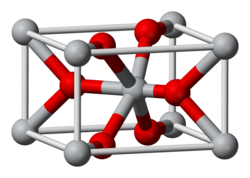 | |
 | |
| Names | |
|---|---|
| IUPAC name Rhenium(IV) oxide | |
| Other names Rhenium dioxide | |
| Identifiers | |
3D model (JSmol) | |
| ChemSpider | |
| ECHA InfoCard | 100.031.659 |
| EC Number |
|
PubChem CID | |
CompTox Dashboard (EPA) | |
| |
| |
| Properties | |
| ReO2 | |
| Molar mass | 218.206 g/mol |
| Appearance | gray orthorhombic crystals |
| Density | 11.4 g/cm3 [1] |
| Melting point | decomposes at 1000 °C [2] |
| insoluble | |
| Solubility in alkali | insoluble |
| +44.0·10−6 cm3/mol | |
| Structure | |
| Orthorohmbic, oP12 | |
| Pbcn, No. 60 | |
| Hazards | |
| NFPA 704 (fire diamond) | |
| Safety data sheet (SDS) | Aldrich MSDS |
| Related compounds | |
Other anions | Rhenium(VII) oxide Rhenium(III) oxide Rhenium(III) chloride |
Other cations | manganese(IV) oxide Technetium(IV) oxide |
Except where otherwise noted, data are given for materials in their standard state (at 25 °C [77 °F], 100 kPa). | |
Rhenium(IV) oxide or rhenium dioxide is the inorganic compound with the formula ReO2. This gray to black crystalline solid is a laboratory reagent that can be used as a catalyst. It adopts the rutile structure.
